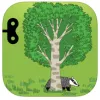Take a look inside 5 images
Plants by Tinybop
Pros: Lots of interactive features, colorful graphics, and cool sound effects make learning fun.
Cons: Unstructured learning style may not work well for some kids. Scientific information about plants is limited.
Bottom Line: Engaging interactive resource on biomes encourages open-ended exploration, but don't expect kids to learn a lot of details about plants.
If you're teaching kids about Earth's biomes, particularly the desert or temperate forest, start the lesson by having kids explore the biomes in Plants by Tinybop with a partner or in small groups. Read the discussion questions aloud first so kids know what to think about as they explore. Then come together as a class and review the discussion questions. To extend the information about plants, invite each student to research and present a brief oral report about one plant found in the targeted biome.
Plants by Tinybop is an open-ended learning tool that encourages kids to explore at their own pace. Adults must set up user accounts in the dashboard, which is nice for sharing devices in the classroom. At the home screen, kids tap their user icon to get started. They can choose either the desert or the temperate forest. In each biome, kids tap and drag to explore plants and animals in their natural habitat. They can also plant seeds, make it rain, and spin a dial to observe daily cycles. Kids can drag a slider across the bottom of the screen to observe life beneath the soil. Colorful graphics and fun sound effects enhance the experience and make it engaging for kids of all ages.
Plants by Tinybop is an interactive diorama that takes kids on a virtual journey through two different biomes: desert and temperate forest. Kids can explore each biome and its plant and animal life by tapping or dragging interactive features. They can learn about plants, animals, seasons, and general weather conditions in the biomes. When kids tap a plant, they learn the name of the plant and explore some of its characteristics. For example, when kids tap the alfalfa plant in the desert biome, the name of the plant appears on the screen above a seed buried in soil. Kids can tap a cloud to make it rain and watch as the seed grows into an adult alfalfa plant. They can spin a dial to observe what happens from sunrise to sunset and how a biome changes with the seasons. Learning is very open-ended, and free exploration is the name of the game with this app, which works well for some kids. Many kids will need some guidance to get the most out of the learning experience, however. A free, downloadable handbook on the developer's website is an excellent resource. It includes more detailed information about the biomes and a series of discussion questions to share with kids.













